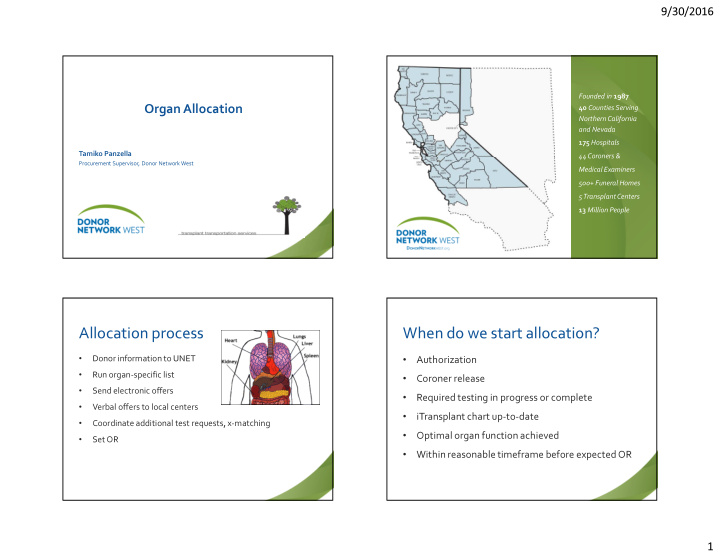



9/30/2016 Founded in 1987 40 Counties Serving Organ Allocation Northern California and Nevada 175 Hospitals Tamiko Panzella 44 Coroners & Procurement Supervisor, Donor Network West Medical Examiners 500+ Funeral Homes 5 Transplant Centers 13 Million People Heal a life through organ and tissue donation Allocation process When do we start allocation? • • Donor information to UNET Authorization • Run organ-specific list • Coroner release • Send electronic offers • Required testing in progress or complete • Verbal offers to local centers • iTransplant chart up-to-date • Coordinate additional test requests, x-matching • Optimal organ function achieved • Set OR • Within reasonable timeframe before expected OR 1
9/30/2016 Recipient Ranking Allocation by Organ: Heart • List screens by ABO, HLA, • Distance • age, size, gender, hxCAD, ABO DCD, HBV, HCV • Medical urgency • Recipients are ranked by • Wait time medical urgency • Longevity matching Sample Heart List Allocation by Organ: Lungs • List screens by ABO, HLA, age, size, smoking hx, DCD, HBV, HCV • Recipients ranked by L ung A llocation S core (LAS) 2
9/30/2016 Allocation by Organ: Liver Allocation by Organ: Liver • List screens by ABO, age, AREA STATUS size, DCD, HBV, HCV, peak Local > Regional Adult/Pediatrics Status 1A -> Pediatric Status 1B lab values (Na, AST, ALT, Local > Regional MELD 40 INR) Local > Regional MELD 39 • Recipients are ranked by Local > Regional MELD 38 Local > Regional MELD 37 medical urgency Local > Regional MELD 36 Local > Regional MELD 35 Local MELD 34-16 Regional MELD 34-16 National Status 1 – MELD 15 Allocation by Organ: Kidneys Allocation by Organ: Kidneys • List screens by ABO, HLA, • KAS (Kidney Allocation System) Started 12/2014 • KDPI, age, size, DCD, DM, Allocation based on KDPI (Kidney Donor Profile Index) HTN, HBV, HCV, creatinine • Donor age, ethnicity, creatinine, HTN hx, DM hx, height, weight, DCD/BDD, • Recipients ranked by wait COD, HCV status • Allocation sequences: KDPI 0-20; 21-34; 35-85; >85 time, HLA matching, longevity matching • Highly sensitized recipients are prioritized 3
9/30/2016 Allocation by Organ: Pancreas • List screens by ABO, HLA, age, size, DCD, DM, HTN, HBV, HCV, labs • Pancreas, Combined Kidney-Pancreas, Islet • Recipients ranked by wait time Allocation by Organ: Intestine When can we set the OR? • • List screens by ABO, age, HCV, HBV, CMV, DM, GI disease Case-by-case basis • Recipients ranked by medical urgency • Organs placed/ backed up as needed • Combined liver/intestine recipients receive priority on liver • Recovery teams identified list. – Pancreas team recovers all abdominals – If no pancreas, liver team recovers – If no liver, kidney team recovers – Thoracic teams generally recover their own organs 4
9/30/2016 Procurement Cold Ischemic Time Limits • OPO brings supplies and instruments • Moment of Silence Heart 4-6 hours • Warm dissection Lungs 4-8 hours • Cross Clamp Liver 12 hours • Back table Kidney 24-48 hours Pancreas 10-16 hours Small Bowel 10-14 hours Preservation Technology Special Considerations • • Kidney pumping PHS Increased Risk • • Heart in a box DCD • • Lung in a box HIV + • • OrganOx (liver pumping) VCA 5
9/30/2016 Transplant Travel Logistics Best Practices for Safe Organ Team Travel 12667 Alcosta Blvd., suite 500 San Ramon, CA 94583 Scott Pritchard President, Transplant Transportation Services, Inc. tpanzella@dnwest.org Heal a life through organ and tissue donation Things that an informed client should know Flight Process Overview • Qualified crew and aircraft Request from OPO Request from OPO Logistics Planning Logistics Planning Post flight Post flight (Activity Report) (Activity Report) • Third Party vetting • Destination • Qualified Crew • Process review • Appropriate plane • OR time • Allocation for • Insurance • Third party audit • Pax Names billing • Weather • UNOS • Invoice generation • Potential delays (air or ground) • DOB • Pilot duty time limitations • After hour services • Organs (helps us identify the • Ground transportation appropriate • Unforeseen delays • Contingency plan airplane) • Weather 6
9/30/2016 A few Best Practices & Understandings Common Operator Challenges & Common Misunderstandings � Flight departments understanding the timeline (thoracic vs. abdominal) � We like to be the “conduit between aviation and transplant medicine” • Turbine engines ARE safer than piston engines � Industry wide there is a massive pilot shortage • Twin engines ARE safer than single engines � Effects experience base • Two pilots ARE better than one. (Note: Approximately 78% of accidents were � Enough staff to have the ability to respond timely single pilot*) � Cost • Pilots ARE NOT typically at the airport waiting to fly – allow time for � Luggage/supplies considerations proper preparation � FAA duty time limitations (14 hours total ~12.5 for the client) • Does your operator utilize third party auditing � Passenger specific requests for aircraft types – we want to make everyone • Forecast volume and forecast weather happy. � The inherent clinical / administrative tug in terms of aircraft used, ground transportation and food as it relates to cost Robert Breiling & Associates, Jan. 2014 Questions? Scott Pritchard, Transplant Transportation Services, Inc. scott@transplanttransportationservices.com 800-915-7190 ext. 3 7
Recommend
More recommend